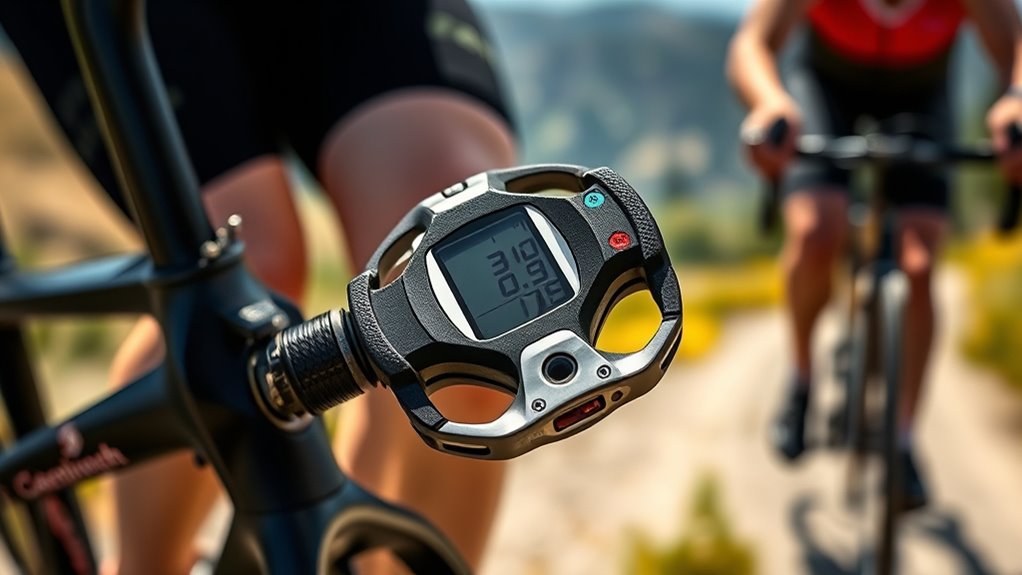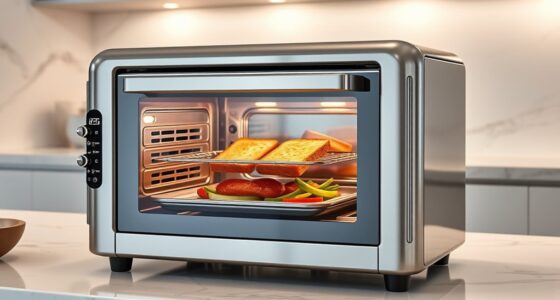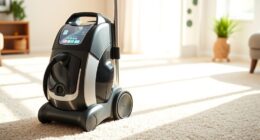If you’re looking to boost your cycling performance, I recommend exploring some of the best power-meter pedals like the Favero Assioma series, Magene P715, and Garmin Rally RK100. These pedals offer high accuracy, reliable connectivity, and durable designs that suit different cycling styles. They’re easy to install and provide real-time data to help you train smarter. Keep going, and you’ll discover detailed insights on choosing the perfect power pedals for your needs.
Key Takeaways
- High-precision pedals like Favero Assioma and Garmin Rally offer ±1% accuracy for reliable performance tracking.
- Compatibility with various cleats and devices ensures seamless integration with road, gravel, and MTB bikes.
- Long battery life and quick magnetic charging minimize downtime during extended training sessions.
- Durable, weather-resistant designs with lightweight materials provide reliable use in all outdoor conditions.
- Features like dual-sided measurement, detailed metrics, and easy installation enhance training effectiveness and user experience.
Magene P715 Power Meter Pedals for Cycling
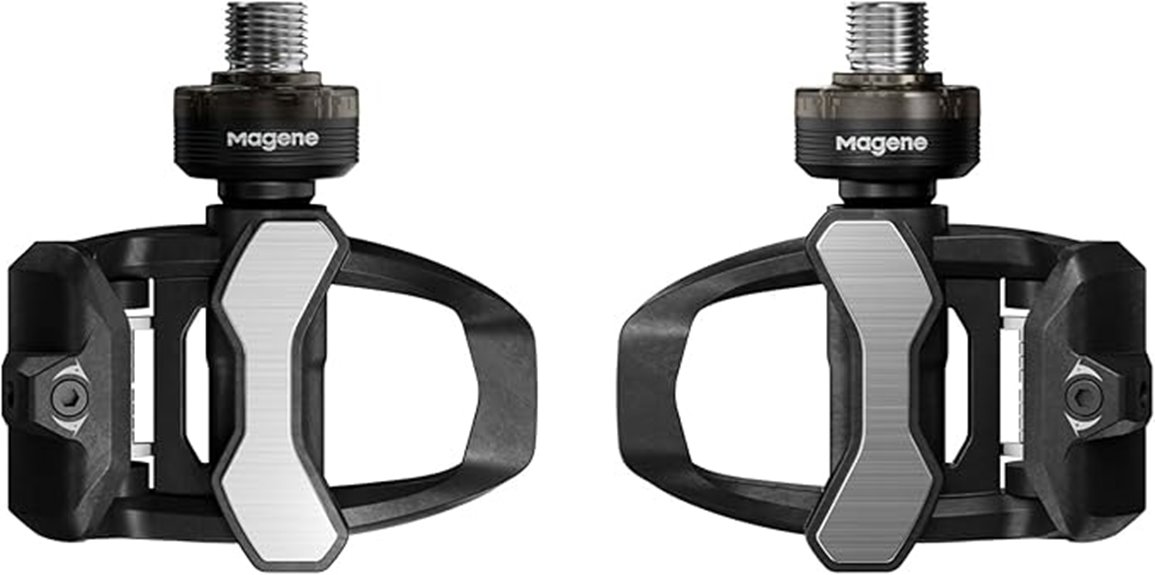
If you’re serious about tracking your cycling performance with pinpoint accuracy, the Magene P715 Power Meter Pedals are an excellent choice. They offer ±1% power measurement accuracy, ensuring reliable data every ride. Designed for easy compatibility, they support KEO cleats, Bluetooth, and ANT+ protocols, making setup straightforward with most devices. Weighing just 157 grams each and built from durable aluminum, they’re lightweight and weather-resistant with an IPX7 rating. Installation takes about a minute, and their impressive 120-hour battery life means you can focus on training without frequent recharging. These pedals truly combine precision, convenience, and durability for dedicated cyclists.
Best For: Serious cyclists and training enthusiasts seeking highly accurate, durable, and easy-to-use power measurement pedals for indoor and outdoor riding.
Pros:
- ±1% high precision power measurement for reliable data
- Supports KEO cleats, Bluetooth, and ANT+ for broad device compatibility
- Long-lasting 120-hour battery life with magnetic charging for convenience
Cons:
- Slightly heavier than some competing models at 315 grams per pedal
- Installation and calibration may require initial setup time for optimal accuracy
- Limited color options, primarily available in black
Favero Assioma PRO RS Power Meter Pedals with Wearable4U Bundle
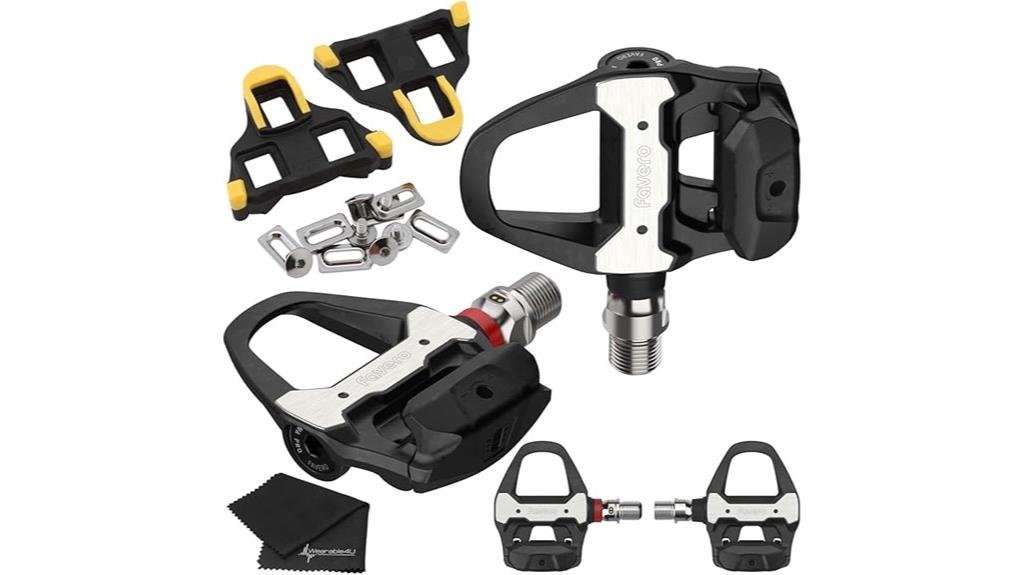
Cyclists seeking precise, reliable power measurement paired with long-lasting performance will find the Favero Assioma PRO RS Power Meter Pedals with Wearable4U Bundle to be an excellent choice. These pedals feature a left-side power sensor, are compatible with Shimano SPD-SL cleats, and are built with durable carbon-fibre tech-polymers. Weighing only 123.5 grams per side, they’re lighter than Shimano Dura-Ace pedals. With ±1% accuracy and over 60 hours of rechargeable battery life, they’re perfect for serious training. The bundle includes cleats, greasing tools, and a magnetic charging cable, making installation and maintenance straightforward. Reputable reviews praise their precision, durability, and lightweight design.
Best For: Serious cyclists and triathletes seeking highly accurate, durable, and lightweight power meters for extensive training and performance tracking.
Pros:
- Highly accurate ±1% power measurement even with oval chainrings
- Long-lasting rechargeable batteries providing over 60 hours of use per charge
- Lightweight design at just 123.5 grams per pedal, lighter than many competitors
Cons:
- Limited to Shimano SPD-SL cleats, which may not suit all pedal systems
- Only one pedal contains a power sensor, requiring pairing with the other for full dual-sided data
- Higher price point compared to basic pedal models, reflecting advanced features and accuracy
Favero Assioma Uno Pedal Power Meter with Cleats and Cleaning Cloth Bundle
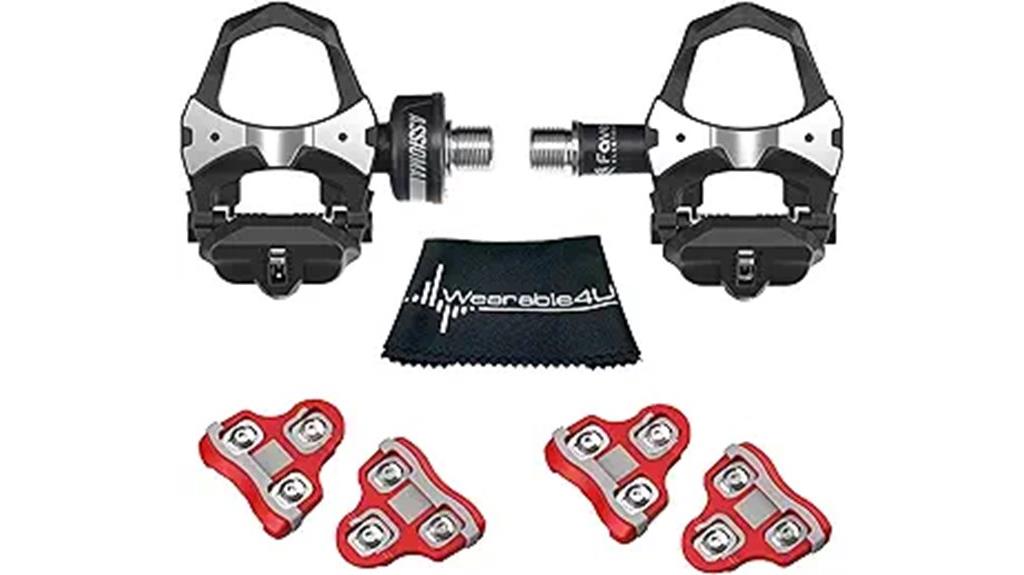
The Favero Assioma Uno Pedal Power Meter with Cleats and Cleaning Cloth Bundle stands out as an excellent choice for serious riders seeking accurate, reliable power measurement without the hassle of complicated installation. It offers precise left-leg power data, easy transfer between bikes, and a sleek, lightweight design. The package includes pedals, Favero Red Float Cleats, and a cleaning cloth, making setup straightforward—about 30 minutes with tools included. Rechargeable batteries last up to 50 hours, and the pedals measure cadence, torque, and pedal smoothness. Compatible with Garmin devices, they deliver dependable data, though some users report occasional connectivity issues.
Best For: serious cyclists and triathletes seeking accurate, easy-to-transfer power measurement to optimize performance across multiple bikes.
Pros:
- Precise left-leg power measurement and comprehensive pedaling analytics
- Easy installation and quick transfer between bikes with included tools
- Rechargeable batteries with long-lasting 50-hour life and seamless data compatibility with Garmin devices
Cons:
- Occasional connectivity issues with certain Garmin models affecting data registration
- Limited customer support options for troubleshooting and technical assistance
- Slightly higher cost compared to basic clipless pedals without power measurement features
Assioma UNO Side Pedal Based Power Meter

For those seeking precise and reliable power measurement without complicated setup, the Assioma UNO Side Pedal-Based Power Meter stands out as a top choice. I found it incredibly easy to install and calibrate, taking just about 10-15 minutes. Its accuracy is impressive, providing real-time data that matches other high-end meters like Wahoo and Stages. The pedals are lightweight, durable, and connect seamlessly via Bluetooth and ANT+. Battery life is excellent, offering over 50 hours of use per charge. Many users, including myself, appreciate how simple it is to switch between bikes and the stable connectivity, making it a reliable tool for improving performance.
Best For: cyclists seeking a highly accurate, easy-to-install power meter that offers seamless connectivity and long battery life for road biking.
Pros:
- Extremely easy to install and calibrate within 10-15 minutes
- Provides precise, real-time power data that matches high-end meters
- Long-lasting rechargeable batteries with over 50 hours of use per charge
Cons:
- Slight spinning when clipping in or adjusting pedal tension
- Durability of the tension adjustment screw may be a concern over time
- Limited to road bikes with a 9/16 inch thread, not suitable for other bike types
Assioma Duo Side Pedal Based Power Meter
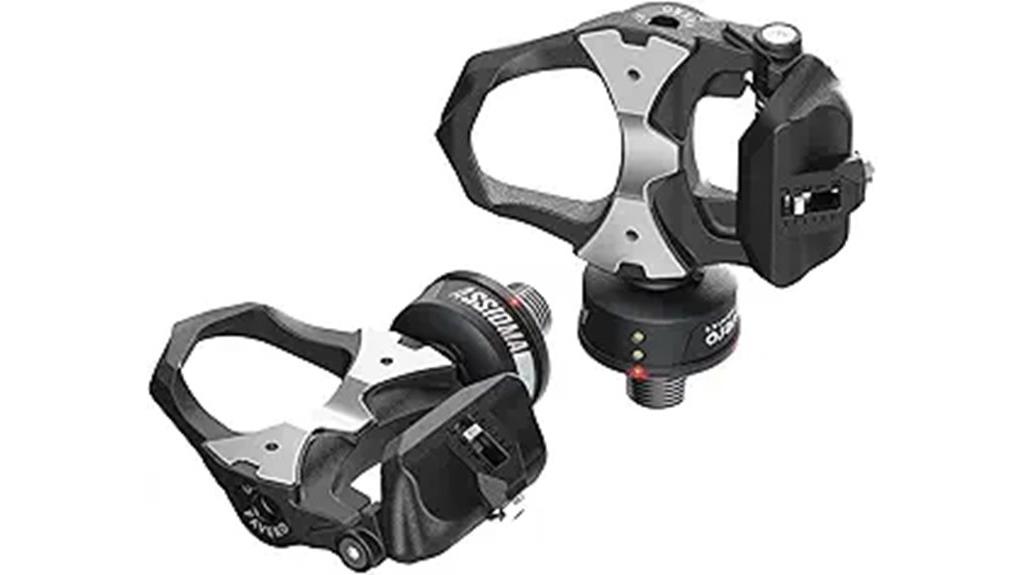
If you’re looking for a pedal-based power meter that combines accuracy with ease of use, the Assioma Duo Side Pedal Power Meter from Favero Electronics is an excellent choice. I appreciate its simple installation, lightweight design, and integrated rechargeable batteries that last around 50 hours per charge. The dual sensors on both pedals provide detailed insights into left/right balance, helping me improve my technique. It connects seamlessly via Bluetooth and ANT+, ensuring reliable data transfer to my bike computer or smartphone. The pedals are durable, sleek, and compatible with road bikes, making them a versatile and dependable tool for serious training.
Best For: cyclists seeking a highly accurate, easy-to-install pedal-based power meter with detailed left/right balance insights for serious training and performance improvement.
Pros:
- Easy installation and quick calibration process, taking less than 30 seconds
- Dual-sided sensors provide comprehensive left/right pedal balance data
- Long-lasting rechargeable batteries offering approximately 50 hours of use per charge
Cons:
- Slightly higher price point compared to basic pedal models
- Slow email response times from customer support may delay issue resolution
- Travel mode requires a charger to disable, which could be inconvenient during frequent travel
Favero Assioma PRO MX-1 Cycling Power Meter with Bluetooth & ANT
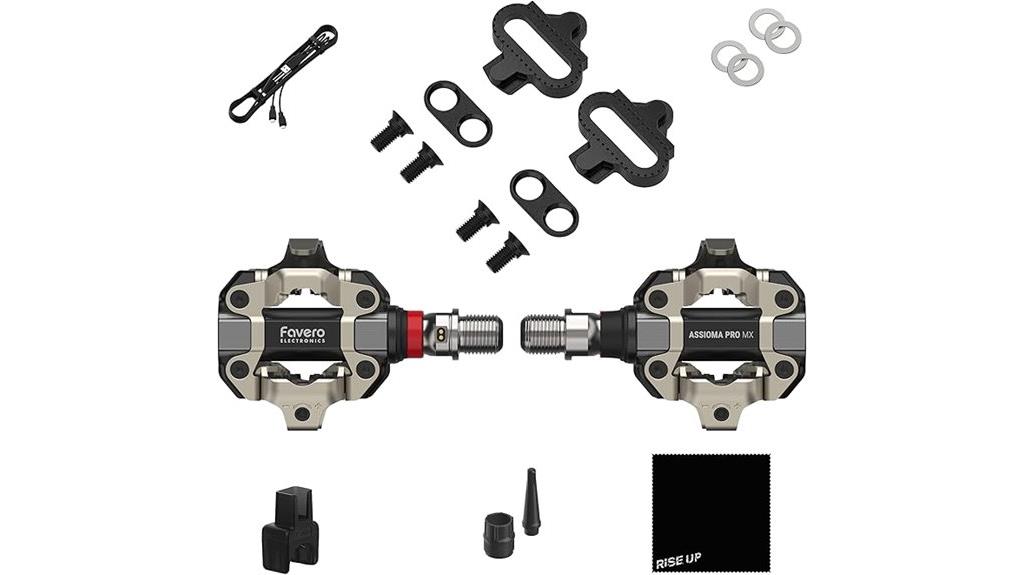
Cyclists who prioritize durability and compatibility will find the Favero Assioma PRO MX-1 ideal, especially those riding MTB or gravel bikes. This pedal-based power meter features a lightweight, shock-resistant aluminum body with a modular design that easily swaps between road and MTB setups. It’s compatible with any crank arm, oval or round chainrings, and crank boots. The single-sensing left pedal provides accurate power data within ±1%, thanks to advanced sensors and temperature compensation. With Bluetooth and ANT+ connectivity, it pairs effortlessly with cycling devices, delivering reliable metrics like cadence, left/right balance, and pedal smoothness, all built to withstand tough terrains.
Best For: cyclists who need a durable, versatile, and highly compatible power meter for MTB and gravel riding, emphasizing reliability and advanced metrics.
Pros:
- Lightweight, shock-resistant aluminum body ensures durability across tough terrains
- Modular design allows quick swapping between road and MTB setups without changing sensors
- Accurate power measurement within ±1% with advanced sensors and temperature compensation
Cons:
- Only features a single-sensing side pedal left pedal, not providing complete left/right power data
- Requires charging via magnetic connector, which may be less convenient than traditional ports
- Slightly higher cost compared to basic pedal-based power meters due to advanced features and durability
Garmin Rally RS100 Single-Sensing Power Meter Pedals
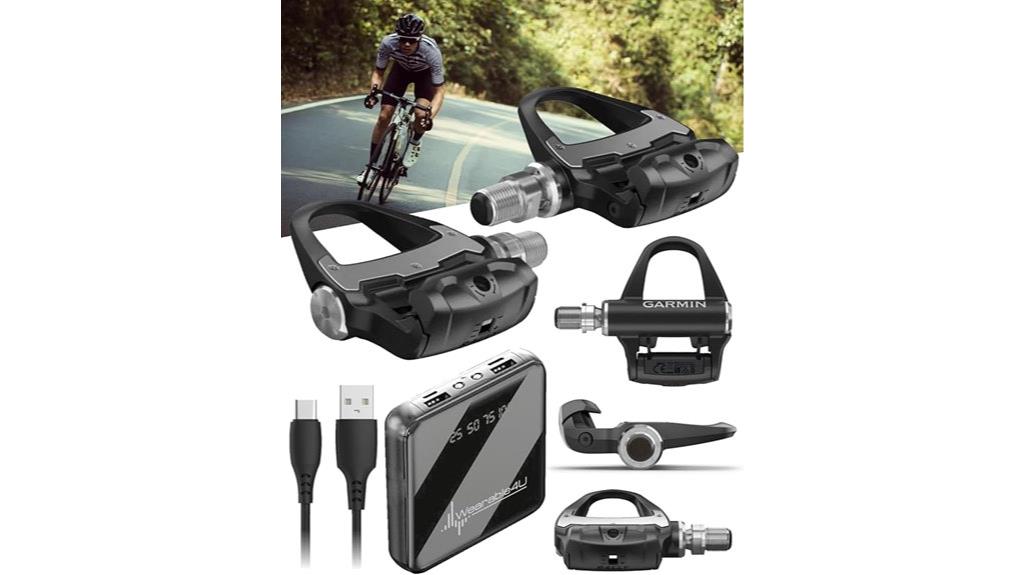
The Garmin Rally RS100 Single-Sensing Power Meter Pedals stand out as an ideal choice for riders looking for reliable, accurate data without the complexity of dual-sensing systems. They measure power and cadence by recording data from the left pedal and doubling it for total power, simplifying setup and maintenance. Compatible with Shimano SPD-SL cleats, they ensure secure engagement, making them perfect for road cyclists. With transferable spindles, these pedals suit various bikes, including gravel and cyclocross. Designed to withstand tough conditions, they deliver consistent performance across disciplines. Seamlessly pairing with Garmin Edge devices, they provide real-time insights and easy software updates, boosting your training efficiency.
Best For: cyclists seeking a reliable, easy-to-maintain power meter pedal system that provides accurate left-side power data and integrates seamlessly with Garmin devices.
Pros:
- Simplifies setup by measuring only the left pedal and doubling for total power, reducing calibration time
- Compatible with Shimano SPD-SL cleats for secure engagement and efficient riding
- Transferable spindles allow use across multiple bike types including road, gravel, and cyclocross
Cons:
- Single-sensing system does not capture right-side power data, limiting detailed analysis of bilateral balance
- May require an upgrade to dual-sensing for comprehensive performance metrics
- Limited to Garmin Edge compatibility for optimal pairing and data management
Favero ASSIOMA PRO MX Series Power Meter Pedals with Power Bank Bundle

For serious cyclists looking to optimize their training with precise power data, the Favero ASSIOMA PRO MX Series Power Meter Pedals with Power Bank Bundle stand out as a top choice. These pedals offer ±1% accuracy, Bluetooth and ANT+ compatibility, and are suitable for both road and mountain biking. They include a durable aluminum build, easy installation, and support multiple bikes. The bundle comes with a power bank, SPD cleats, and necessary tools, making setup and charging straightforward. With weather-resistant design and real-time metrics, they’re reliable in all conditions, helping you track performance and improve your ride.
Best For: serious cyclists and training enthusiasts seeking precise, reliable power data for both road and mountain biking in all weather conditions.
Pros:
- Highly accurate with ±1% measurement precision using IAV Power System
- Compatible with Bluetooth and ANT+ for seamless connectivity with various devices
- Durable aluminum construction with IP67 certification for water, mud, and dust resistance
Cons:
- Pairing issues may occur with certain devices, requiring troubleshooting
- Charging port placement could be vulnerable to impacts without protective covers
- Slightly heavier weight (~1.33 kg) may be noticeable for some riders during long rides
Favero Assioma Uno Pedal Cycling Power Meter Bundle
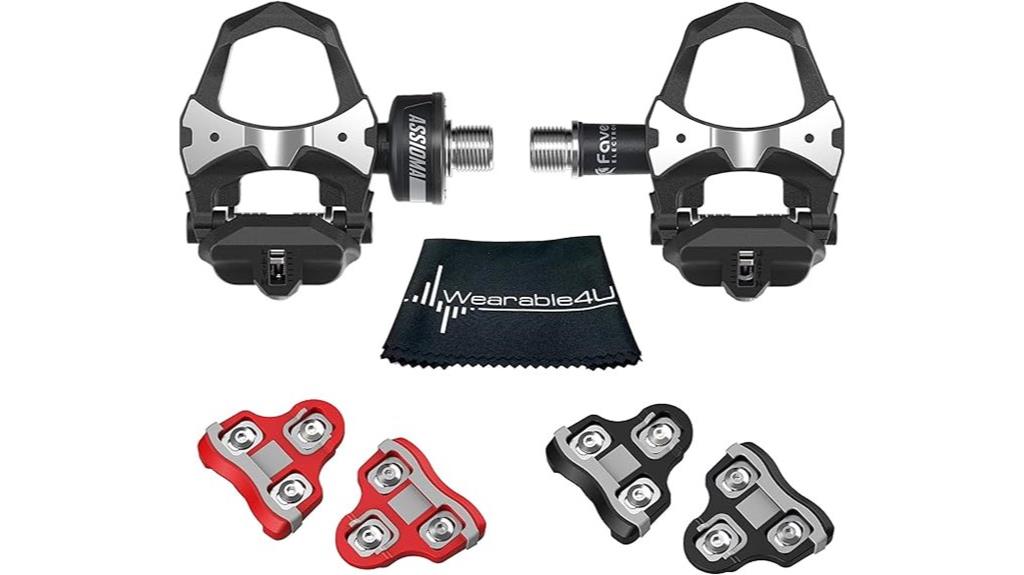
If you’re seeking an affordable yet highly accurate power-meter pedal, the Favero Assioma Uno Bundle is an excellent choice. It includes a single pedal with a true left sensor, offering precise leg power data, plus Favero Red and Black Float Cleats, and a cleaning cloth. Made for road bikes, it’s lightweight, easy to install, and transfers between bikes effortlessly. The pedal provides detailed metrics like left/right balance, torque, and pedal smoothness, with rechargeable batteries lasting up to 50 hours. Users praise its affordability, accuracy, and seamless device compatibility, though some mention occasional connectivity issues. Overall, it’s a reliable, user-friendly option for cyclists looking to improve performance.
Best For: cyclists seeking an affordable, accurate, and easy-to-use power meter pedal to enhance training and performance.
Pros:
- Highly accurate power measurement with true left sensor for precise data
- Easy installation and seamless compatibility with Garmin, Zwift, and other cycling devices
- Rechargeable batteries lasting up to 50 hours, eliminating the need for frequent replacements
Cons:
- Occasional connectivity issues with certain devices like Garmin Edge 1030
- Limited dedicated customer support for troubleshooting technical problems
- Some users report minor difficulties with data registration or device pairing
Assioma UNO Side Pedal Based Power Meter
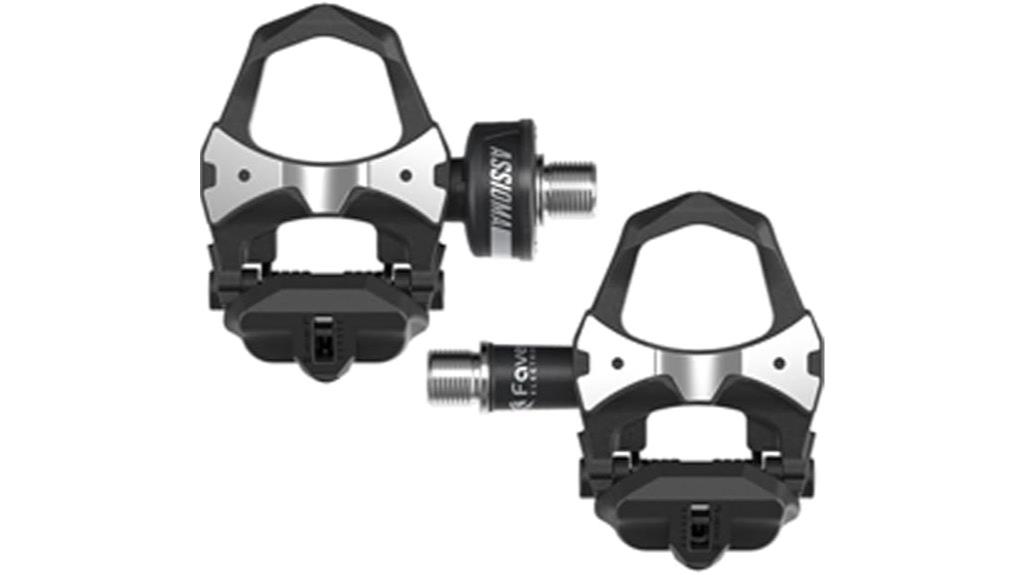
Cyclists seeking precise, reliable power data that’s easy to install and switch between bikes will find the Assioma UNO Side Pedal-Based Power Meter an excellent choice. It delivers highly accurate watt measurements, thanks to extensive research and development, and syncs seamlessly via Bluetooth and ANT+. Setup is quick—around 10-15 minutes—including charging, pairing, and calibration. The pedals are lightweight, durable, and designed for road bikes, with simple zero-offset calibration when switching bikes. Users praise its stable connectivity, long battery life of over 50 hours, and ease of use. Overall, the Assioma UNO offers a dependable, user-friendly option for cyclists serious about tracking performance.
Best For: cyclists who want highly accurate, reliable power data with easy installation and seamless bike switching.
Pros:
- Precise watt measurement thanks to extensive R&D, ensuring high accuracy
- Easy setup within 10-15 minutes, including charging, pairing, and calibration
- Long battery life of over 50 hours and stable Bluetooth/ANT+ connectivity
Cons:
- Slight spinning when clipping in or adjusting pedal tension for some users
- Durability of the tension adjustment screw may vary over time
- Price point may be higher compared to basic pedal options
Favero ASSIOMA PRO MX Series Power Meter Pedals with Power Bank Bundle
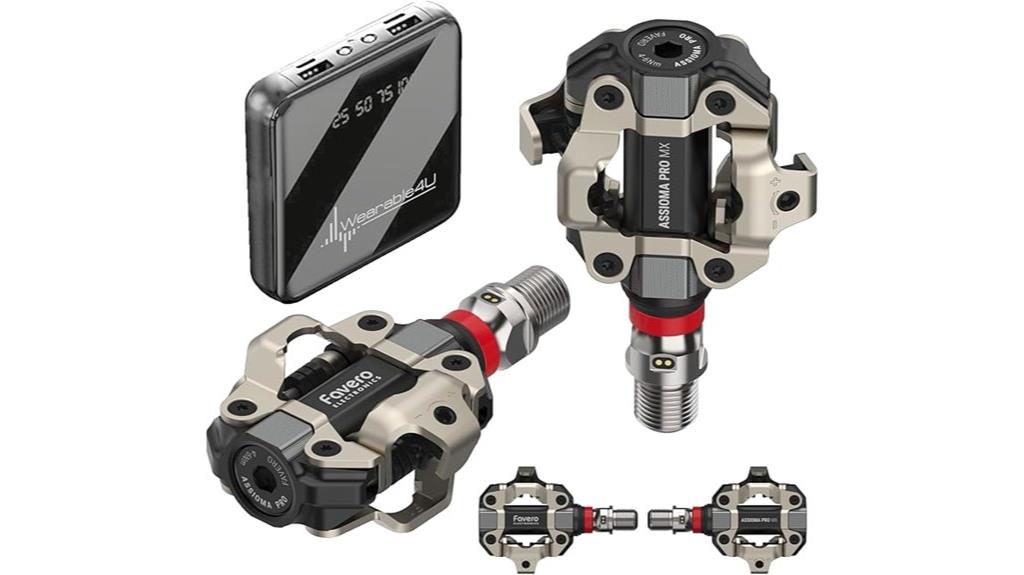
The Favero ASSIOMA PRO MX Series Power Meter Pedals with Power Bank Bundle stand out as an excellent choice for serious riders seeking precise, reliable data across diverse terrains. These pedals are compatible with most bike computers and apps via Bluetooth and ANT+, making setup straightforward. Built from durable aluminum and resistant to water, mud, and dust, they’re perfect for both road and mountain biking. The package includes sensors, MTB-compatible cleats, and a power bank, ensuring extended use. With ±1% accuracy and robust construction, they deliver consistent performance even in tough conditions. This bundle offers great value for riders who demand durability and precise metrics.
Best For: serious cyclists and triathletes seeking accurate, durable power data across various terrains with multi-bike compatibility.
Pros:
- High-precision measurement with ±1% accuracy using IAV Power System
- Durable construction with aluminum 6061-T6, resistant to water, mud, and dust
- Easy multi-bike setup and comprehensive data compatibility via Bluetooth and ANT+
Cons:
- Charging port location may be vulnerable to impacts without protective cover
- Possible pairing issues with some devices or bike computers
- Slightly heavier than some competitors, around 1.33 kg
Wearable4U Favero Assioma Pedal Bike Power Meter with Multi-Tool Bundle
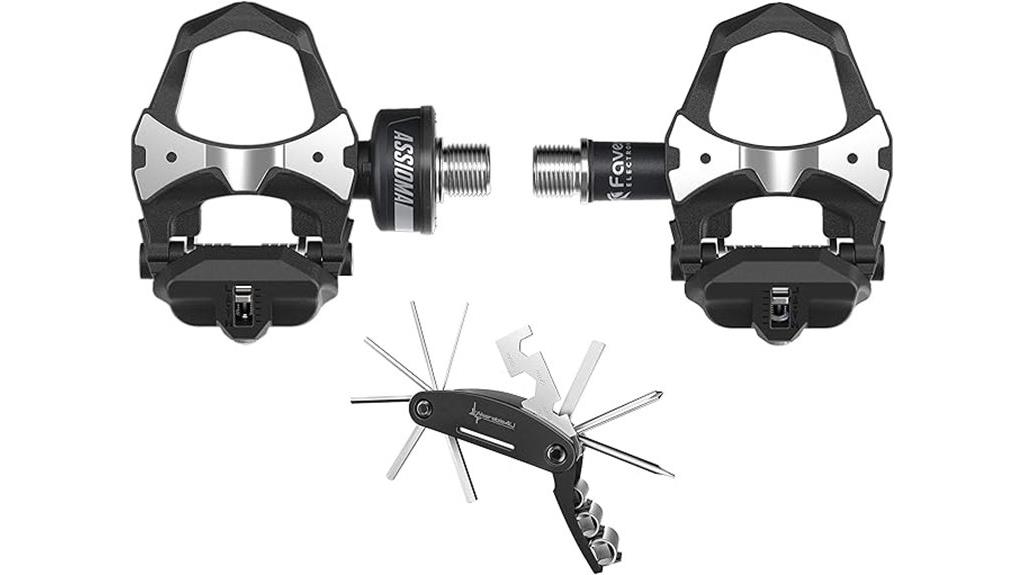
For riders who want precise, pedal-level power measurement combined with a convenient multi-tool bundle, the Wearable4U Favero Assioma UNO Pedal-Based Bike Power Meter stands out. It provides accurate left-side power data through its sensor in the pedal, along with detailed metrics like cadence, torque efficiency, and pedal smoothness. Easy to install and transfer between bikes, it requires no special tools, making setup quick. With rechargeable batteries lasting up to 50 hours and magnetic charging connectors, it’s highly portable. The included multi-tool bundle ensures I can perform maintenance and adjustments on the go, maximizing the pedal’s performance and my training efficiency.
Best For: cyclists seeking precise pedal-level power data with easy bike transfer and a handy multi-tool for maintenance on the go.
Pros:
- Provides accurate left-side power measurement and comprehensive pedal analytics
- Easy to install, transfer, and compatible with multiple bikes without special tools
- Rechargeable batteries last up to 50 hours with simple magnetic charging
Cons:
- May require initial calibration for optimal accuracy
- Compatibility limited to bikes with compatible pedal systems
- The multi-tool bundle, while useful, may not cover all specific maintenance needs
Favero Assioma Pro MX Power Meter Pedals Bundle with SPD Cleats and Accessories
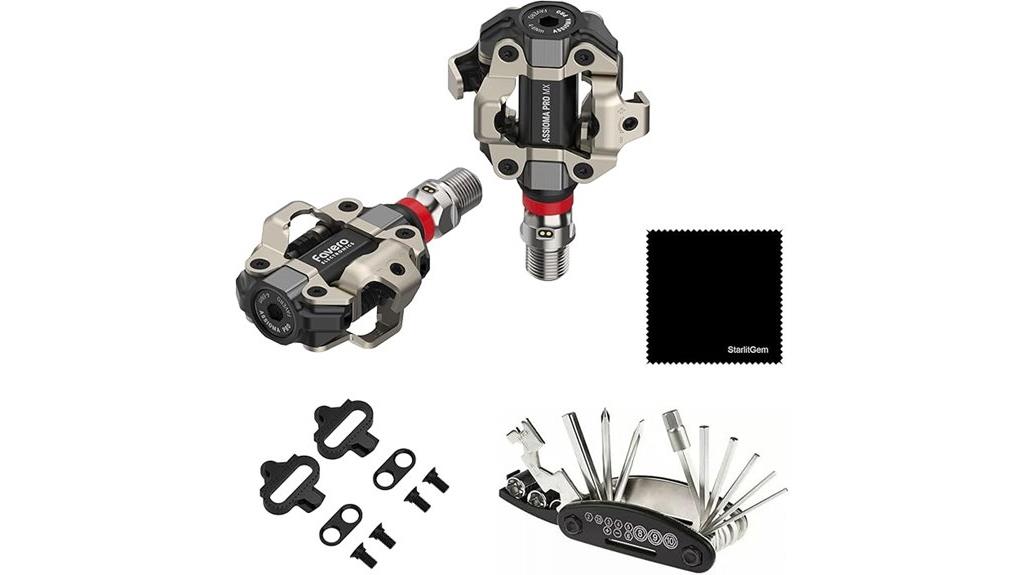
If you’re serious about tracking your performance on MTB or gravel rides, the Favero Assioma Pro MX Power Meter Pedals Bundle stands out as an excellent choice. These dual or single-sided pedals are fully SPD compatible and connect easily via Bluetooth and ANT+, making them compatible with most bike computers, smartwatches, and apps like Zwift and Strava. Built from lightweight aluminum, they’re shock and impact resistant, with rechargeable batteries providing up to 60 hours of use. Installation is quick and tool-free, and the bundle includes everything needed—SPD cleats, accessories, and maintenance tools—ensuring durability, precise metrics, and seamless integration for serious riders.
Best For: Serious MTB and gravel cyclists seeking durable, accurate, and easy-to-install power measurement pedals with seamless connectivity.
Pros:
- Easy to install and swap between bikes without special tools
- Highly durable construction with shock-resistant materials and protected electronics
- Long-lasting rechargeable batteries providing up to 60 hours of use
Cons:
- Slightly higher price point compared to basic pedal models
- May require initial setup to calibrate for optimal accuracy
- Limited availability until June 25, 2024, depending on market release dates
Magene P715 Power Meter Pedals with ANT+ & Bluetooth
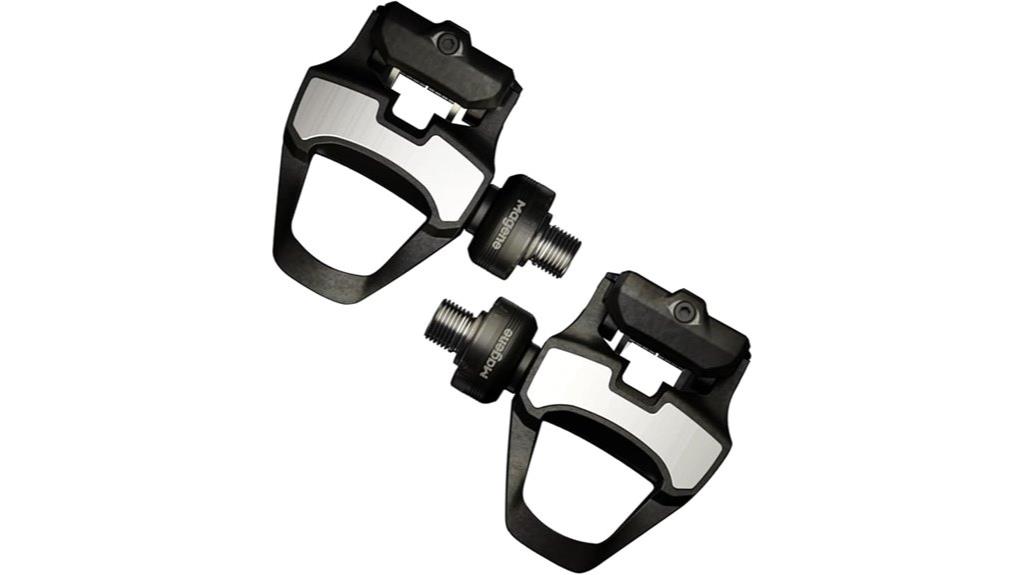
Cyclists seeking precise, reliable power measurement will find the Magene P715 Power Meter Pedals with ANT+ and Bluetooth to be an excellent choice. They deliver ±1% accuracy, ensuring your data is consistent and trustworthy. Weighing just 157 grams per pedal, they’re built from durable aluminum and support KEO cleats, making installation straightforward. The dual ANT+ and Bluetooth support lets you connect seamlessly to various devices, including bike computers and smartphones. With a long-lasting 120-hour battery life and waterproof IPX7 rating, these pedals are ready for any weather. Plus, they’re easy to install in just a minute, so you can start training right away.
Best For: cyclists who want highly accurate, durable, and easy-to-install power meters for both indoor and outdoor training.
Pros:
- ±1% precise power measurement for reliable data
- Supports Bluetooth and ANT+ for versatile device connectivity
- Long-lasting 120-hour battery life and IPX7 waterproof rating
Cons:
- Slightly heavier than some competing pedals at 157 grams per pedal
- Limited to KEO cleats, which may not suit all cyclists’ preferences
- First availability set for June 9, 2025, which may delay purchase for some users
Garmin Rally RK100 Power Meter Bike Pedals Bundle
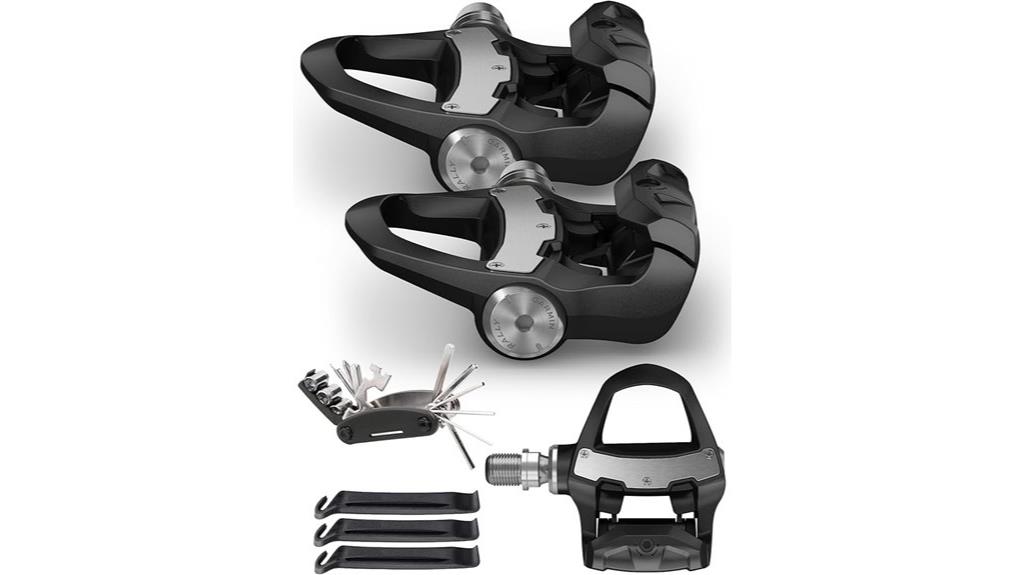
The Garmin Rally RK100 Power Meter Bike Pedals Bundle stands out as an ideal choice for serious road riders seeking precise performance insights. Designed for road bikes and compatible with LOOK KEO cleats, it offers easy installation and smooth progression between rides. The power meter accurately tracks total power and cadence, with a battery life of around 120 hours. Seamlessly integrating with Garmin’s ecosystem, it allows firmware updates via watches, Edge devices, or smartphones. Plus, the included repair kit makes on-the-go maintenance simple. While some users note accuracy may decline after about 6,000 miles, overall, it’s a reliable tool for dedicated cyclists aiming to optimize their performance.
Best For: serious road cyclists seeking precise power and cadence data to optimize their performance and training.
Pros:
- Accurate measurement of total power and cadence for detailed performance analysis
- Seamless integration with Garmin ecosystem for easy updates and data sharing
- Includes a compact repair kit for on-the-go maintenance
Cons:
- Accuracy may decline after approximately 6,000 miles (~2 seasons)
- Slightly higher price point compared to basic pedals without power measurement
- Customer reviews suggest some users experience calibration or connection issues over time
Factors to Consider When Choosing Power‑Meter Pedals for Cyclists
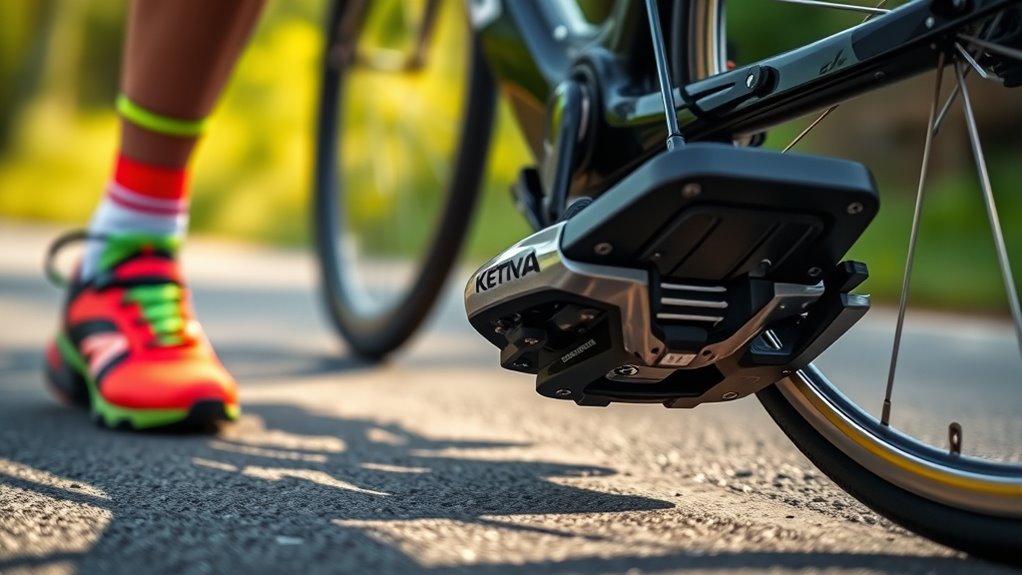
When choosing power-meter pedals, I always consider how accurate the measurements are, since precise data is essential for tracking progress. Compatibility with my devices and the pedals themselves also matters, so I look for standards that match my bike and gadgets. Ultimately, I pay attention to battery life and how easy it is to install, ensuring I won’t be troubleshooting or replacing batteries too often.
Power Measurement Accuracy
Achieving accurate power measurements is vital for effective training and performance analysis, and selecting pedals with reliable sensors plays a significant role. High-quality pedals typically offer ±1% accuracy, providing precise data that I can trust. These pedals use advanced sensors and calibration processes to deliver consistent readings across different riding conditions. However, factors like oval chainrings, temperature changes, and pedal tension can influence the data’s accuracy, so regular calibration is essential. Dual-sided pedals measure power on each leg separately, offering deeper insights into my balance and performance. Proper installation and ongoing maintenance help preserve measurement precision over time. Considering these factors ensures I get reliable data to optimize my training and improve my cycling performance effectively.
Compatibility With Devices
Choosing power‑meter pedals that are compatible with your devices is essential for seamless data integration and efficient training. Make sure they support Bluetooth and ANT+ protocols to connect smoothly with cycling computers, smartphones, and training apps. Check that the pedals work with your specific cleat system, like Shimano SPD-SL or LOOK KEO, to ensure secure attachment and proper function. Verify the maximum supported device types—whether it’s a bike computer, smartwatch, or indoor trainer—to match your setup. Confirm that the pedals can pair effortlessly with your preferred platforms, such as Garmin, Wahoo, Zwift, or Strava. Additionally, look for pedals that support firmware updates through compatible devices, helping you stay current with evolving software and hardware standards. Compatibility is key to maximizing your training potential.
Pedal Compatibility Standards
Understanding pedal compatibility standards is essential because they determine whether a power-meter pedal will fit your bike and work seamlessly with your gear. The key factor is the cleat system supported—such as Shimano SPD-SL or LOOK KEO—as this affects fitting and engagement. Additionally, you need to confirm the pedal’s thread size matches your crank arm, typically 9/16 inch for most adult road bikes. Some pedals offer multi-bike compatibility through quick-release mechanisms or interchangeable spindles, which is convenient if you ride different bikes. Compatibility also extends to digital protocols like Bluetooth and ANT+; these ensure smooth data transfer to your cycling devices. Finally, verify that the cleat system and electronic interfaces align with your shoes and bike computer for effortless integration.
Battery Life Duration
Battery life duration is a crucial factor when selecting power-meter pedals, as it determines how long you can train or ride without interruptions for recharging. Longer battery life lets you focus on your ride, especially during multi-day events or long-distance trips. Look for pedals offering at least 50 hours of battery life to avoid frequent recharging. Quick-charging rechargeable batteries can minimize downtime, keeping you ready for your next session. Keep in mind that usage, temperature, and additional features like backlighting or data logging can affect battery longevity. Also, a clear battery status indicator is helpful so you can monitor remaining power and plan recharges accordingly. Choosing pedals with reliable, long-lasting batteries ensures your training isn’t disrupted, helping you maintain consistent performance.
Installation Ease
Installing power-meter pedals should be quick and straightforward, so I look for models that can be set up in under 10 minutes without complicated tools. Pedals with simple, tool-free installation and clear, step-by-step instructions make the process smooth. Many pedals now include app-guided calibration, which ensures proper setup and accurate data collection. If I switch bikes often, I prefer pedals that support quick transfer between bikes, saving time on setup. It’s also essential to verify compatibility with my crank arm thread size, usually 9/16 inch, to avoid installation issues. Good pedals come with extensive accessories like washers, cleats, and magnetic charging cables, which streamline the process. Overall, ease of installation is key to getting started quickly and accurately.
Durability and Weatherproofing
When choosing power-meter pedals, durability and weatherproofing are essential to guarantee they perform reliably in all riding conditions. Look for pedals with an IPX7 or higher waterproof rating to ensure protection against heavy rain and splashes. Materials like aluminum or carbon-fiber composites resist impact, corrosion, and wear over time, extending their lifespan. Make sure the electronic components are housed in sealed, shock-resistant casings to prevent damage from shocks, mud, or debris. Reinforced charging ports and connectors that resist dust, water ingress, and impacts are also vital. Additionally, it’s wise to select pedals tested in various weather conditions, ensuring they maintain accuracy and reliability whether you’re riding in rain, mud, or cold temperatures. Robust construction guarantees consistent performance no matter the environment.
Weight and Performance
Choosing the right power-meter pedals involves balancing weight and performance to enhance your riding. Lighter pedals, usually under 300 grams each, help reduce rider fatigue and make climbing easier. They also improve acceleration and responsiveness, especially during sprints or technical maneuvers. High-performance pedals with ±1% accuracy ensure precise data collection without adding unnecessary weight. Using durable materials like aluminum or carbon fiber allows for weight savings while maintaining long-term reliability. It’s crucial to select pedals that don’t compromise responsiveness or data accuracy for weight savings. When choosing, aim for a model that offers an ideal balance, so you get the benefits of lightweight design without sacrificing performance or measurement precision. This balance can greatly boost your overall riding efficiency.
Price and Value
The price of power-meter pedals varies widely, from affordable options around $200 to high-end models exceeding $1,000, depending on features and accuracy. When considering value, I look at durability and whether the pedals are built to withstand weather and impacts, as higher-quality units tend to last longer. The choice between rechargeable and replaceable batteries also affects long-term costs and convenience. Additional features like advanced metrics, easy transfer between bikes, and waterproof ratings can boost perceived value. Ultimately, I compare the cost to the pedal’s accuracy and reliability to ensure I get a good balance of performance and longevity for my investment. This approach helps me choose pedals that offer true value, not just a low price tag.
Frequently Asked Questions
How Do I Calibrate My Power-Meter Pedals Accurately?
Calibrating my power-meter pedals accurately is key to reliable data. I make sure I’m on a flat, steady surface, then warm up my bike for about 10 minutes. Next, I follow the manufacturer’s instructions, usually pressing a calibration button or riding at a low, consistent power level. I repeat the process regularly, especially after bike maintenance or weather changes, to keep my readings precise and trustworthy.
What Is the Typical Battery Life of These Power-Meter Pedals?
Ever wondered if your power-meter pedals come with a lifetime supply of batteries? Sadly, no. Most last around 50 to 100 hours of riding, which means you’ll be swapping them out more often than your favorite jersey. Luckily, many pedals use rechargeable batteries or have easy-to-replace coin cells. So, pack some spares and keep pedaling without the dreaded power outage ruining your ride!
Are These Pedals Compatible With All Bike Types and Cleats?
When considering power-meter pedals, I always check their compatibility with my bike and cleats. Not all pedals work with every bike type or cleat system, so I make sure to choose one that matches my setup—whether it’s SPD, Look, or Shimano. I recommend verifying the pedal’s specifications and cleat compatibility before buying, so you can be confident it’ll fit your bike and riding style perfectly.
How Do I Interpret Data From Different Power-Meter Pedal Brands?
Interpreting data from different power-meter pedal brands can seem tricky at first. I recommend starting by understanding each brand’s metrics and how they present data, like FTP, cadence, and power zones. I always double-check calibration instructions and compare readings with known benchmarks. Remember, consistency is key. Once you get familiar with how each brand displays info, you’ll be able to analyze your performance more accurately and make smarter training decisions.
What Maintenance Is Required to Keep the Pedals Functioning Properly?
To keep my power-meter pedals working well, I regularly clean the contacts and sensors with a soft cloth and mild cleaner. I also check for loose parts or corrosion and tighten any bolts if needed. Periodically, I update the pedal firmware and replace batteries to guarantee accurate readings. Proper maintenance helps me avoid issues and get reliable data on every ride, so I can improve my performance consistently.
Conclusion
If you’re serious about boosting your cycling performance, choosing the right power-meter pedals is key. With options like Favero’s Assioma series and Magene’s P715, you can find a perfect fit for your needs. Are you ready to see how these pedals can transform your rides and push your limits? Remember, the right gear can make all the difference—so why not take that next step toward cycling excellence today?
